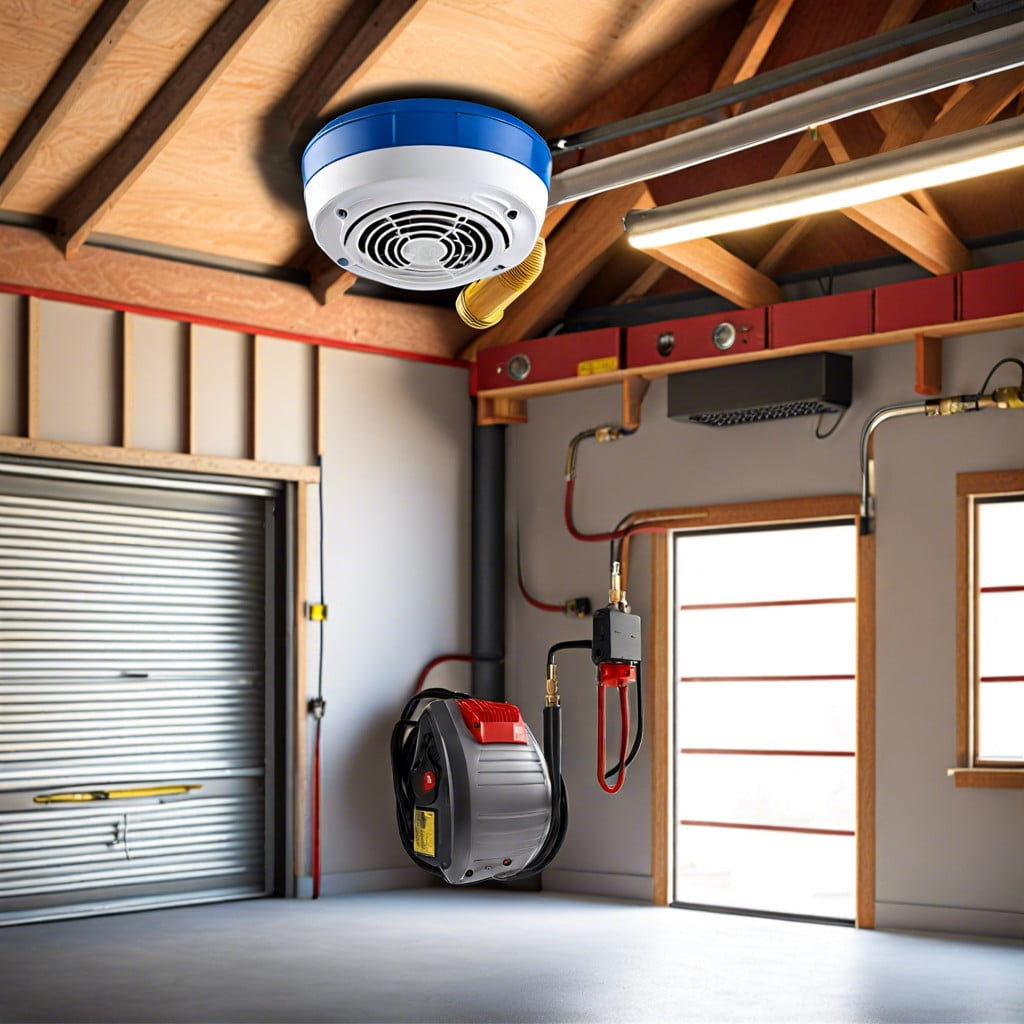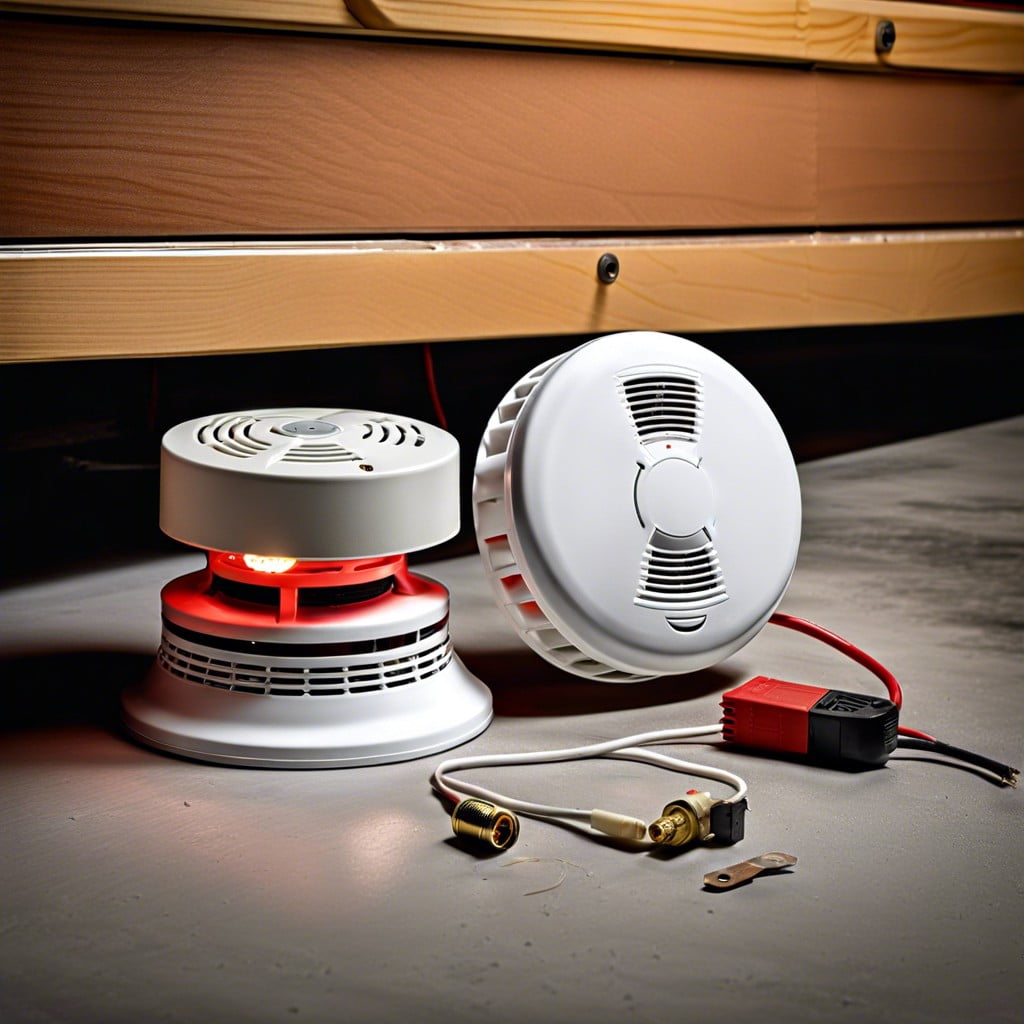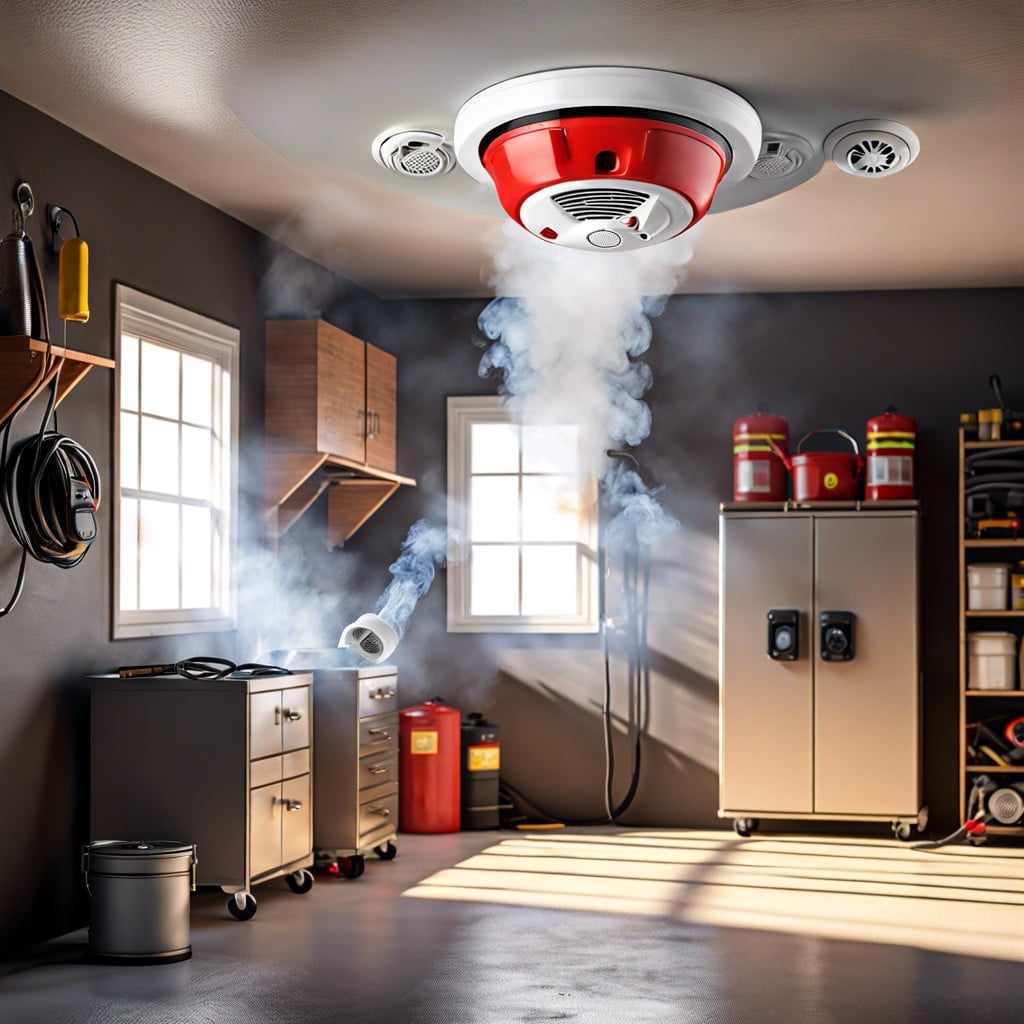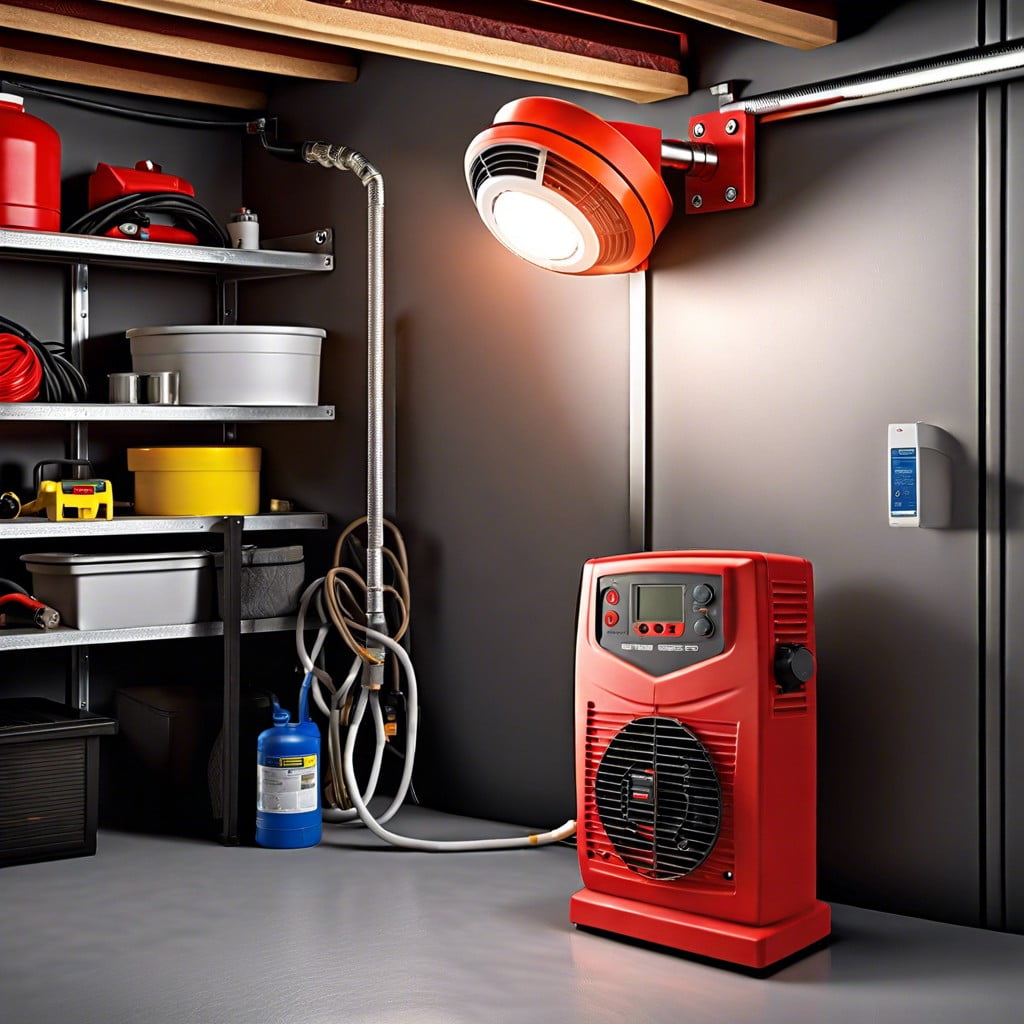Exploring the benefits of heat detectors versus smoke detectors for your garage is crucial because understanding their unique features can dramatically enhance safety at home.
Key takeaways:
- Heat detectors respond to rapid temperature rises in garages.
- Heat detectors have fixed temperature or rate-of-rise options.
- Heat detectors are ideal for garages with flammable materials.
- Heat detectors are not a replacement for smoke detectors.
- Regular maintenance and testing ensure heat detector functionality.
Garage Heat Detectors

Heat detectors serve a critical role in garage safety, sensing rapid temperature rises or extreme heat rather than smoke. Unlike typical household smoke detectors, they are less prone to false alarms from dust and exhaust fumes often present in garage environments.
When selecting a heat detector, consider two main types: fixed temperature, which triggers an alarm when a specific temperature is reached, and rate-of-rise, which detects sudden spikes in temperature. Both technologies provide valuable protection for garages, which house combustible materials like gasoline and oil.
Ideally, a heat detector in a garage should be placed on the ceiling, away from drafts caused by windows or doors, ensuring the unit’s rapid and accurate response to developing fires. Remember, heat detectors complement smoke alarms but do not replace them entirely; a layered approach to fire detection is always best for comprehensive safety.
Smoke Detector Vs Heat Detector

Understanding the differences between smoke detectors and heat detectors is crucial for optimal garage safety. Smoke detectors activate upon detecting smoke particles, functioning best in living spaces where fires typically start with smoldering materials, giving occupants early warning.
Heat detectors, in contrast, respond to temperature changes, ideal for garages where combustible materials ignite quickly and generate heat without much smoke initially.
A heat detector’s alert mechanism is triggered by either a rapid temperature increase, referred to as rate-of-rise sensors, or when temperatures reach a specific threshold, known as fixed temperature detectors. The prior responds swiftly to sudden heat surges, while the latter reacts once heat reaches a preset danger point.
Selecting between these devices depends on the garage’s function. If it’s used for woodworking or storing flammable liquids and vehicles, a heat detector may offer a more suitable response, negating false alarms from dust or fumes that may affect smoke detectors. For attached garages, incorporating both types of detectors could provide layered protection, alerting to diverse fire behaviors. Regular testing ensures functionality when it matters most.
Types of Fires for Heat Detection

Understanding the kinds of fires that heat detectors are designed to identify is crucial for ensuring optimal protection in your garage. Heat detectors primarily respond to changes in temperature, which can occur during different types of fire scenarios, such as:
- Flaming Fires: These are characterized by large flames and can result from flammable liquid spills or electrical malfunctions. A rapid rate-of-rise heat detector is sensitive to quick temperature increases and is suitable for such conditions.
- Smoldering Fires: These fires may not produce significant flames but can cause a slow, sustained increase in ambient temperature. Fixed temperature heat detectors are apt for detecting the gradual build-up of heat from these fires.
- Combustible Material Fires: Garages often store items like gasoline, solvents, and paints which can ignite quickly. Both types of heat detectors can provide early warnings in these situations.
Selecting the right heat detector based on the most likely fire scenario in a garage will enhance safety and responsiveness in the event of an emergency.
Heat Detector Benefits

Heat detectors in garages offer distinct advantages for fire prevention and safety. Unlike smoke detectors, they are not triggered by dust or exhaust fumes, common in garage environments. Their activation depends on significant temperature increases, making them well-suited to spaces where smoke detectors might cause false alarms.
Another benefit is their durability. Designed to withstand harsher conditions, heat detectors perform reliably in areas subject to temperature extremes, as garages often are. This resilience ensures consistent operation over time.
The placement of heat detectors is also more flexible. While smoke rises, causing smoke detectors to require optimal placement near the ceiling, heat detectors monitor ambient temperature and can therefore be installed in a variety of locations, offering greater installation convenience.
Furthermore, in enclosed spaces where flammable materials are stored, a heat detector’s swift response to rapid temperature rises can be crucial in preventing a small incident from escalating into a full-blown fire. Their quick detection provides critical extra minutes for firefighting efforts and evacuation.
Finally, for garages attached to homes, heat detectors add an extra layer of protection to your property by alerting to potential dangers in areas that are often overlooked, helping to safeguard both assets and occupants.
Maintaining Your Heat Detector
Regular maintenance is crucial for ensuring your heat detector functions correctly and provides the necessary safety measures for your garage.
Start by testing the device monthly using the test button—this simple action verifies that the alarm and battery are operational.
Dust and debris can accumulate on the sensors, so it’s important to clean the unit gently with a soft brush attachment on a vacuum every six months to prevent false alarms or failure to detect heat.
Also, check the manufacturer’s guidelines for the lifespan of your heat detector; most need replacing after about ten years.
Replace batteries annually, or as recommended, even if the test indicates they’re still functional.
Keep a maintenance log to monitor checks, cleanings, and battery changes, which can serve as a helpful reminder and record for ensuring your heat detector’s reliability over time.
Garage Carbon Monoxide Detectors
Installing a carbon monoxide detector in your garage safeguards against the silent threat posed by this colorless, odorless gas. Vehicle exhaust is a primary source of carbon monoxide, and a running car in an enclosed space can lead to dangerous levels of this toxic gas within minutes.
Apart from automobiles, other potential sources in a garage include gas water heaters, fuel-fired furnaces, portable generators, and power tools running on combustible engines.
Choosing a detector with a digital display allows you to monitor CO levels constantly. It’s crucial to place the detector at least five feet above the floor since carbon monoxide is slightly lighter than air and will rise.
Ensure that the detector is not located near any fuel-burning appliance to avoid false alarms and not in a location where it could be easily obstructed by vehicles, equipment, or storage items.
Regular testing and battery replacement are paramount; test the detector monthly and replace batteries at least twice a year, often aligned with daylight saving time changes.
Remember that carbon monoxide detectors have a limited lifespan, typically five to seven years, after which they should be replaced to ensure proper functionality.
Maintaining Your Carbon Monoxide Detector
Regular maintenance is crucial to ensure your carbon monoxide detector operates effectively:
1. Test the detector monthly by pressing the test button for a few seconds; the alarm should sound if the detector is functioning.
2. Replace batteries annually, even if the unit is hardwired. Power outages could render hardwired detectors without backup batteries useless.
3. Vacuum the unit’s exterior periodically to prevent dust buildup, which can impede sensor function.
4. Check the manufacturer’s expiration date for your detector, typically 5-7 years, and replace the unit accordingly.
5. Keep a log of testing and maintenance activities to keep track of the device’s health and reliability. This record can be as simple as a note on the inside of a utility closet or a reminder on a digital calendar.
Common Causes of Garage Fires
Electrical malfunctions are a leading instigator of garage fires. Outdated wiring, overloaded circuits, and improper use of extension cords can create a hazardous situation. Clutter near electrical outlets or the storage of flammable liquids like gasoline, paint thinners, and solvents compounds these risks.
Regularly inspecting your garage’s electrical system and keeping flammable materials away from heat sources can significantly reduce fire dangers. Poor maintenance of garage appliances, such as space heaters, can also spark fires. Ensuring these appliances are in good working order and keeping them away from combustibles is critical for safety.
Lastlly, human error, such as leaving a candle burning unattended or smoking in the garage, should not be overlooked as potential fire starters. Stay vigilant about these activities and enforce a strict ‘no open flame’ policy in your garage space.
Can a Heat Detector Work for Your Garage?
Heat detectors offer an alternative to smoke detectors, functioning effectively in environments where dust, exhaust, and fluctuating temperatures might cause false alarms with traditional smoke detectors. In the context of a garage, with its unique mix of hazards, heat detectors are advantageous for several reasons:
- Temperature Sensitivity: Heat detectors are designed to trigger an alarm when the ambient temperature reaches an extreme high or detects a rapid rise in heat, both indicators of a potential fire.
- Reduced False Alarms: Unlike smoke detectors, they are less sensitive to small smoke particles, meaning that normal garage dust, fumes, or exhaust won’t likely set them off.
- Location Suitability: Given the nature of items stored in garages, including flammable liquids and gases, a heat detector can be essential for early fire detection without being affected by everyday garage activities.
- Complementary Safety: While not a replacement for smoke detectors in living quarters, they supplement home safety by securing a high-risk area with a device suited to its conditions.
When selecting a heat detector for a garage, it is important to consider the specific type—rate-of-rise or fixed temperature—based on the average conditions and ambient temperature range in the space. Regular testing and maintenance ensure these devices function properly when needed.
Why Does Your Garage Need a Heat Detector?
Equipping your garage with a heat detector is crucial for several reasons:
1. Flammable Materials: Garages often store fuels, paints, and solvents, which pose a high risk of fire through rapid temperature increase.
2. Temperature Extremes: Unlike living spaces, garages aren’t always climate-controlled and can reach higher heat levels that would cause false alarms with standard smoke detectors.
3. Unattended Space: Fires can start and spread quickly in a garage where there is less frequent human activity to notice and respond to the early signs of a fire. A heat detector ensures an efficient response to these situations by detecting rapid temperature rises.
4. Complementary Safety: When used in conjunction with smoke and carbon monoxide detectors in the home, a heat detector provides an added layer of protection specifically tailored for the unique environment of a garage.
5. Electric and Gas Appliances: If your garage houses a furnace, water heater, or other appliances, a heat detector can offer an early warning before a malfunction turns into a potentially dangerous fire.
Incorporating a heat detector in your garage is a proactive step toward reducing the risk of fire damage to your home and protecting the safety of its occupants.
FAQ
Should you have a smoke detector in your garage?
No, smoke detectors are not necessary or designed for use in garages, albeit their usefulness in home fire safety plans.
Why does my fire alarm go off in my garage?
The fire alarm in your garage may trigger due to car exhaust or excessive dust.
Where should smoke alarms not be placed?
Smoke alarms should not be positioned near fresh air vents, ceiling fans, highly drafty areas, or in areas infested with insects as drafts can prevent smoke from reaching the sensing chamber and insects can cause unwanted alarms.
Where should heat detectors be placed in a garage?
Heat detectors should be placed on or near the center of a flat-finished garage ceiling.
What are the recommended smoke detector types for garages?
The recommended smoke detector types for garages are photoelectric smoke detectors as they are efficient in detecting slow, smoldering fires common in garages.
How frequently should you replace or maintain your garage's smoke detector?
Smoke detectors in a garage should be replaced every 10 years and tested monthly to ensure proper functioning.
How can false alarms in garage smoke detectors be prevented?
To prevent false alarms in garage smoke detectors, ensure the device is installed away from areas where dust, humidity, or temperature fluctuations are common, as these can trigger false alarms.